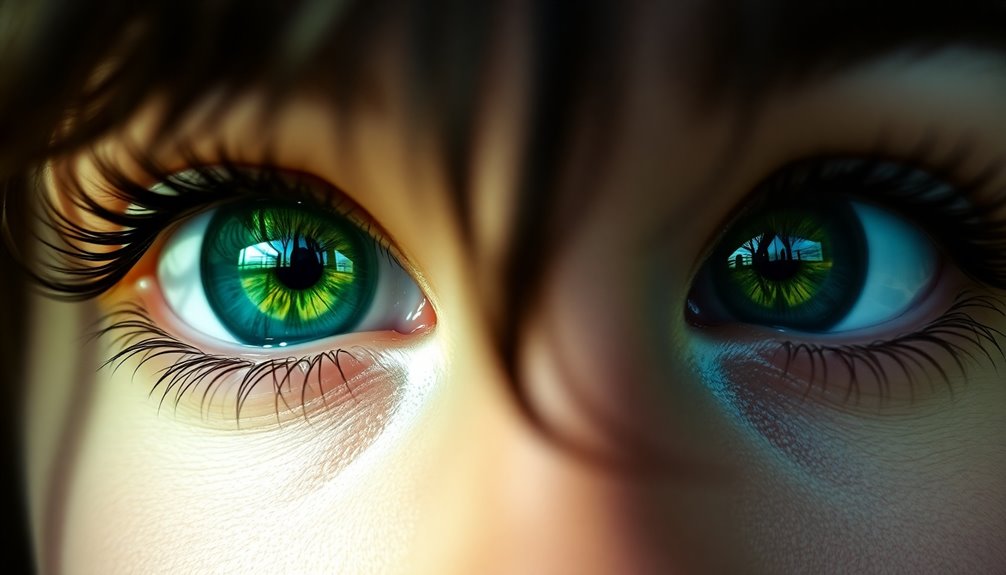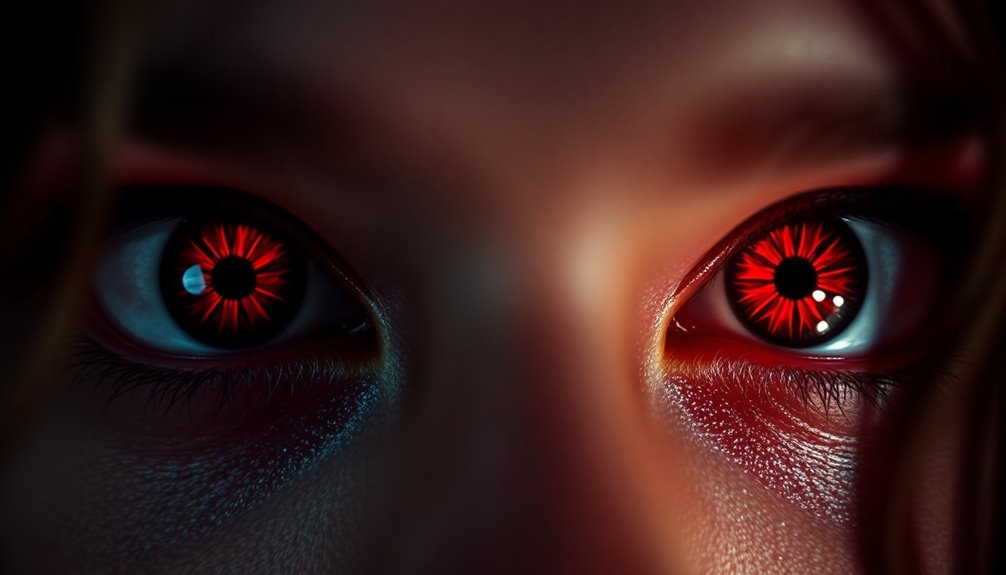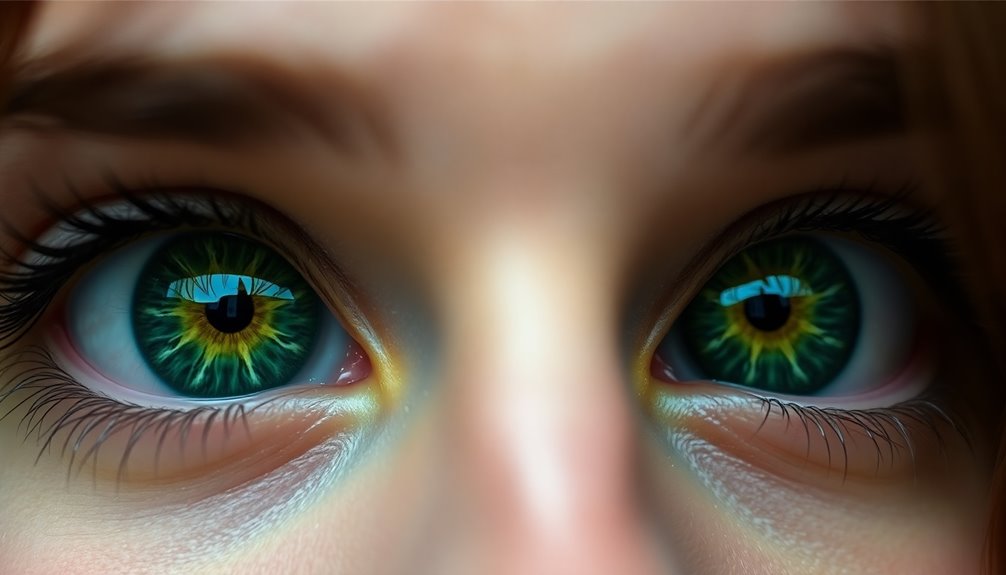Green eyes symbolize rarity and individuality, capturing attention with their vibrant hue. Only 2% of the global population shares this unique trait, often linked to Celtic and Northern European descent. Historically, these enchanting eyes have inspired myths and legends, representing beauty and supernatural qualities. In literature and film, green-eyed characters often embody mystery and emotional depth, enhancing their allure. Modern interpretations celebrate green eyes for their striking appearance and connection to creativity. This emerald gaze invites you to explore deeper meanings hidden within its enchanting brilliance, revealing even more fascinating insights about their significance.
Key Takeaways
- Green eyes symbolize beauty, individuality, and uniqueness, often associated with enchanting qualities in various cultures and eras.
- Historically linked to mystique, green eyes were associated with witchcraft and supernatural abilities in medieval folklore.
- In literature and film, characters with green eyes often embody emotional depth, resilience, and complexity, captivating audiences.
- Cultural narratives celebrate green eyes as symbols of creativity, adaptability, and emotional connection, inviting self-exploration.
- Ancient traditions regarded green eyes as lucky, with connections to healing and protection in societies like Egypt and Celtic cultures.
The Rarity of Green Eyes
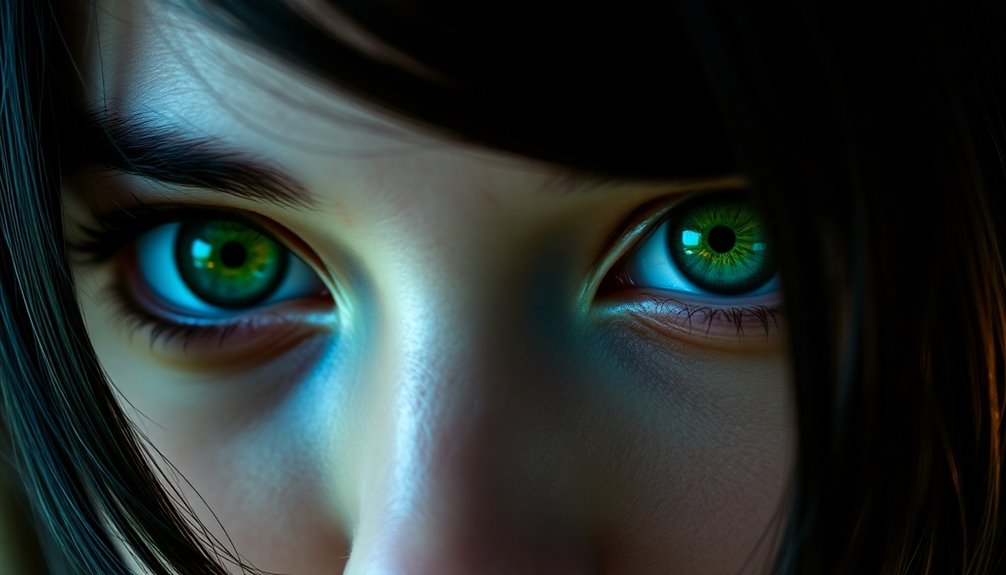
Green eyes are truly a rarity, making up only about 2% of the global population. This unique emerald hue captures attention and often sparks curiosity. The rarity of green eyes stems from their specific genetic basis, involving mutations in the OCA2 and HERC2 genes that regulate melanin and lipochrome levels. This combination results in the striking green coloration that many find enchanting.
You'll notice that the prevalence of green eyes is particularly high among individuals of Celtic and Northern European descent, especially in countries like Ireland and Scotland. This geographic distribution adds to their allure, as you may feel a distinct sense of identity when you share this eye color.
In a world where most people have brown or blue eyes, having green ones can make you stand out. Moreover, the rarity of green eyes is often linked to lighter skin tones, enhancing their uniqueness.
Because of this scarcity, people with green eyes frequently embody a sense of mystique, making their gaze even more fascinating. Embracing this rarity can empower you, allowing you to appreciate the beauty and intrigue associated with your distinct eye color.
Scientific Basis of Eye Color

The enchanting hue of green eyes stems from a complex interplay of genetics that determines eye color. Specifically, two genes, OCA2 and HERC2, play vital roles in the production of melanin, the pigment responsible for eye color. Green eyes result from a moderate amount of eumelanin, which gives darker colors, combined with a higher presence of pheomelanin, leading to that distinctive green shade.
Furthermore, the scientific basis of eye color involves more than just genetics. The perception of green eyes is also influenced by Rayleigh scattering, where shorter wavelengths of light scatter more than longer ones. This phenomenon can enhance the brightness and clarity of your green eyes under different lighting conditions.
Interestingly, only about 2% of the global population has green eyes, making it a rare eye color. You'll find this striking hue more often in Northern European and Celtic populations.
Environmental factors, such as your diet and the lighting around you, can further influence how vibrant your green eyes appear. Understanding this genetic interplay helps you appreciate the beauty behind your emerald gaze.
Historical Perspectives on Green Eyes
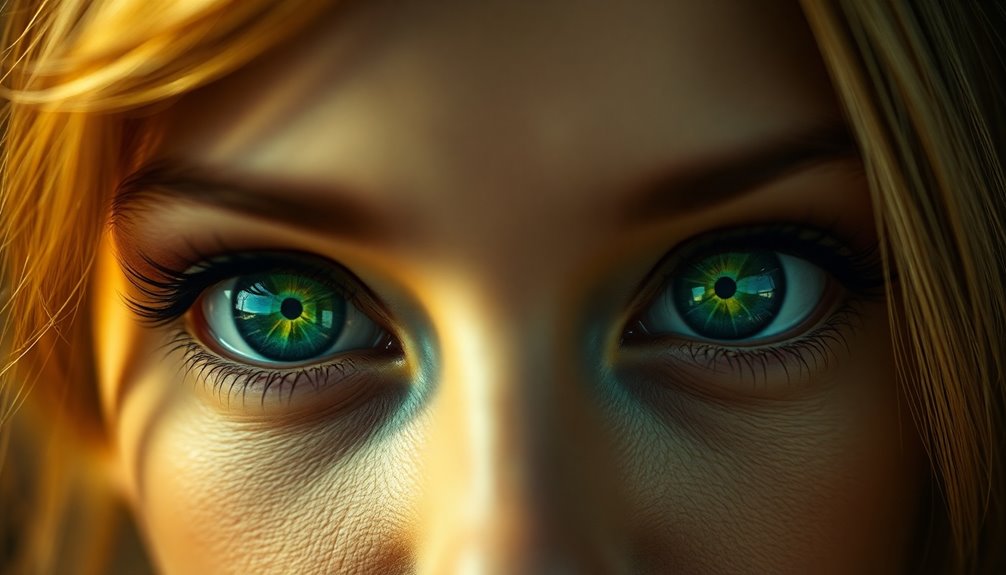
Throughout history, green eyes have sparked numerous cultural myths and legends that shape their perception.
You might find it intriguing how notable historical figures with green eyes have influenced these narratives, often embodying traits of mystery and allure.
As we explore these connections, you'll see how green eyes have been woven into the fabric of different cultures across time.
Cultural Myths and Legends
Linked to various cultural narratives, green eyes have long captured human imagination, weaving through myths and legends that highlight their unique symbolism. In ancient Egypt, for instance, green eyes were associated with the god Horus, symbolizing healing and protection. Greek mythology often depicted the goddess Hera with green eyes, tying them to jealousy and emotional complexity. Celtic tradition celebrates green-eyed individuals as leprechauns, emphasizing luck and mischief.
Here's a brief overview of these cultural connections:
| Culture | Symbolism | Traits Associated |
|---|---|---|
| Ancient Egypt | Healing, protection, rebirth | Supernatural abilities |
| Greek Mythology | Jealousy, emotional complexity | Emotional depth |
| Celtic Tradition | Luck, mischief | Mystical qualities |
Across various cultures, green eyes signify beauty and uniqueness, often viewed as possessing supernatural traits. Shakespearean literature frequently showcases green eyes to convey themes of envy and suspicion, enhancing their cultural significance. Whether you see them as a mark of luck or a symbol of emotional depth, the allure of emerald gaze continues to resonate through history.
Notable Historical Figures
Green eyes haven't only captivated cultural narratives but also left a significant mark on history through notable figures. Cleopatra, with her striking green eyes, epitomized allure and embodied the iconic status that this eye color can convey.
In ancient Egypt, these vibrant eyes were linked to the goddess Hathor, symbolizing fertility and rebirth, showcasing their spiritual significance. Similarly, Greek mythology often illustrated the goddess Hera with green eyes, intertwining them with themes of jealousy and emotional depth.
In medieval Europe, the mystique surrounding green eyes intensified, as they were frequently associated with witchcraft and sorcery, making individuals with this eye color subjects of fascination and suspicion.
This intrigue carried over into artistic representations throughout history, particularly in the Renaissance, where green-eyed figures were often depicted as possessing unique beauty and enchanting qualities, reflecting societal beliefs and values.
These historical figures and their associations with green eyes remind us that this striking color hasn't only shaped personal identities but also influenced cultural narratives, making it a symbol of allure, depth, and intrigue throughout the ages.
Cultural Symbolism of Green Eyes
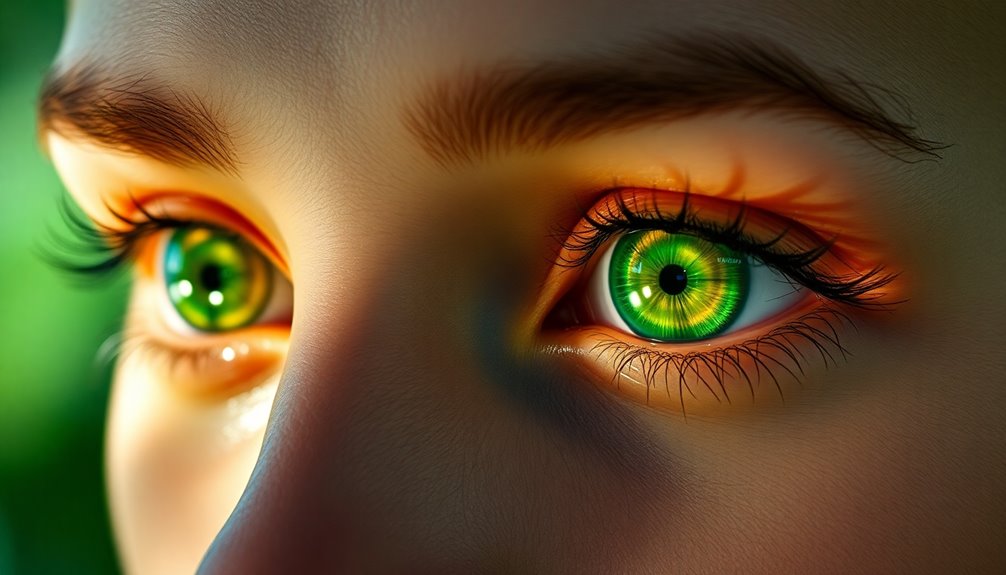
When you think of green eyes, you can't help but notice the mystique and allure they carry across different cultures.
Historically, they've been linked to powerful figures and enchanting tales, while modern interpretations celebrate their uniqueness and creativity.
This rich symbolism invites you to explore the fascinating connections between green eyes and their cultural significance.
Mystique and Allure
There's something undeniably enchanting about green eyes that draws you in and sparks curiosity. With only about 2% of the global population possessing them, green eyes carry a mystique that sets them apart. This rarity not only enhances their allure but also symbolizes beauty and individuality.
Across cultures, green eyes are often linked to supernatural abilities, highlighting a unique emotional depth that captivates many. In ancient Egypt, they were associated with Horus, the god of healing and protection, while Celtic traditions celebrate them as symbols of luck and mischief. These associations deepen the fascination surrounding green eyes, making them a canvas for storytelling and symbolism across time.
Literature and art have romanticized green-eyed characters, often weaving them into narratives filled with mystery and envy, further amplifying their enigmatic appeal.
Today, individuals with green eyes are often seen as striking and unique, embodying a blend of beauty and complexity. From their historical roots to modern perceptions, the mystique and allure of green eyes continue to inspire awe, reminding you that there's always more than meets the eye.
Historical Associations
Throughout history, various cultures have imbued green eyes with rich symbolism and significance, often highlighting their enchanting nature.
You'll find that ancient Egyptians revered green eyes, associating them with the god Horus, symbolizing healing and protection. This connection reflects a deep cultural perception of beauty and mystique surrounding this eye color.
In Greek mythology, green-eyed individuals were frequently linked to Hera, the goddess of jealousy. This duality showcases how green eyes can captivate yet invoke suspicion.
Similarly, Celtic traditions celebrated green-eyed beings like leprechauns as symbols of luck and mischief, further embedding these eyes in folklore as uniquely enchanting.
Shakespearean literature also tapped into this symbolism, using green eyes to convey themes of jealousy and suspicion.
You can see how, over time, societal perceptions of green-eyed characters have evolved, revealing both allure and complexity.
Whether viewed as beautiful or ominous, green eyes carry a rich tapestry of historical associations that continue to fascinate and intrigue.
Embracing these cultural interpretations enhances your understanding of the vibrancy and depth behind the emerald gaze.
Modern Interpretations
Mystique surrounds green eyes, enchanting those who encounter them. These striking features carry significant cultural weight, representing much more than just beauty.
Today, you'll find several modern interpretations that highlight their charm and meaning:
- Rarity and Beauty: With only about 2% of the global population sporting green eyes, they embody uniqueness, enhancing their cultural significance.
- Individuality: Green eyes stand out, symbolizing a person's distinct identity in a world of conformity.
- Luck: Many cultures associate green eyes with good fortune, adding an element of hope and positivity.
- Mystical Qualities: Historically linked to supernatural abilities, green eyes continue to fascinate imaginations in literature and popular culture.
As modern trends in fashion and beauty embrace green eyes, public figures and influencers elevate their status as symbols of exceptional beauty.
Characters like Scarlett O'Hara and Harry Potter further emphasize the depth and charm of the emerald gaze.
In this way, green eyes not only represent beauty but also embody the complex interplay of individuality, luck, and cultural significance, making them a captivating focal point in our contemporary world.
Green Eyes in Literature and Film
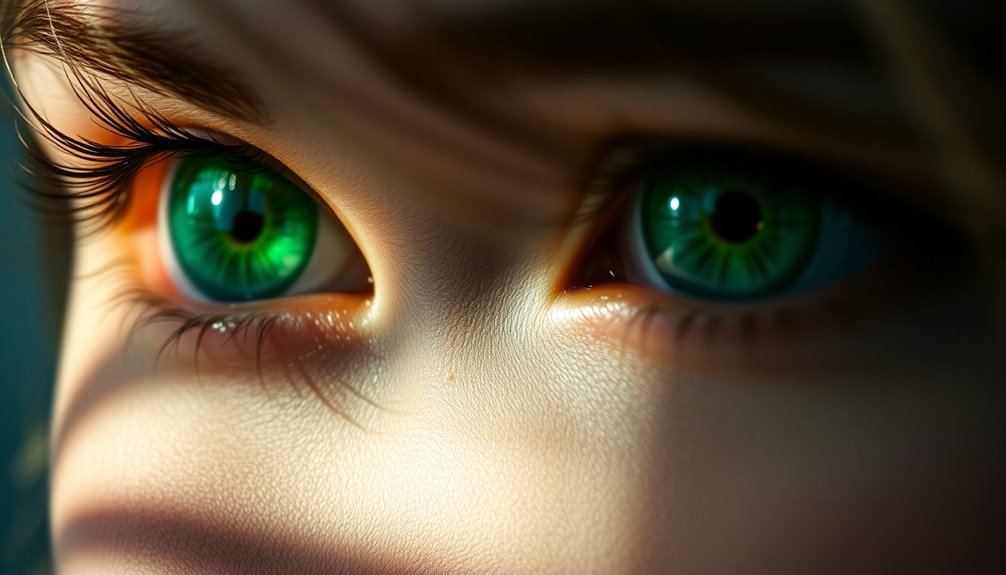
While green eyes often fascinate audiences, they also hold deeper meanings in literature and film. Characters with green eyes frequently symbolize mystery and allure, drawing you in with their emotional depth. For instance, Scarlett O'Hara in "Gone With the Wind" exemplifies this, with her mesmerizing gaze reflecting resilience and complexity.
In various narratives, green-eyed people are portrayed with unique abilities and sometimes supernatural qualities. Harry Potter's iconic green eyes signify a profound connection to magic and destiny, enhancing the charm of green eyes in popular culture.
Here's a glimpse of how green eyes are represented across different mediums:
| Medium | Example |
|---|---|
| Literature | Scarlett O'Hara – "Gone With the Wind" |
| Film | The Green Mile – John Coffey |
| Music | "Green Eyes" – Coldplay |
These characters resonate with audiences not only due to their striking appearance but also because of the emotional resonance they evoke. Whether through the lens of literature or film, green-eyed characters often embody the enigmatic charm that keeps you enthralled.
Psychological Insights and Interpretations
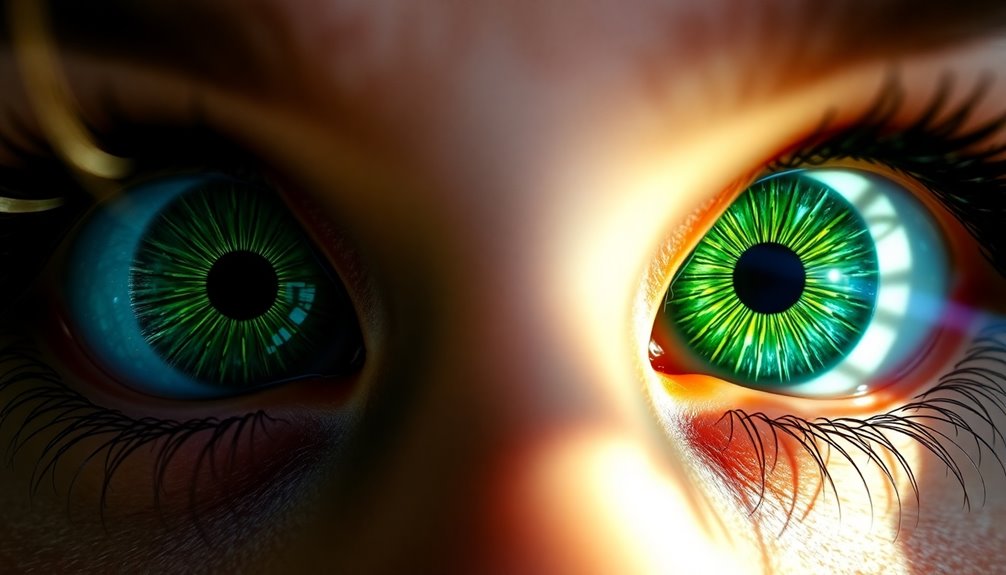
Green eyes carry a significant psychological weight, often signaling deeper emotional qualities and traits in individuals. Their rarity—found in only about 2% of the global population—adds to their psychological allure, evoking mystery and intrigue.
If you have green eyes, you might embody several unique characteristics:
- Emotional Depth: You likely possess a strong connection to your inner self, allowing you to empathize deeply with others.
- Creativity: People with green eyes often gravitate toward artistic or unconventional paths, showcasing their individuality and imaginative spirit.
- Adaptability: Your ability to navigate complex social dynamics helps you understand subtle emotional cues, making you a keen observer of human behavior.
- Cultural Perceptions: While some narratives link green eyes to jealousy, this often reflects society's struggle with the emotional complexities tied to this eye color.
Embracing these traits, you can harness your emotional depth and creativity, enhancing your connections with others.
Ultimately, green eyes symbolize a rich tapestry of individuality and empathy, inviting deeper exploration of the self and the world around you.
Environmental Influences on Eye Color
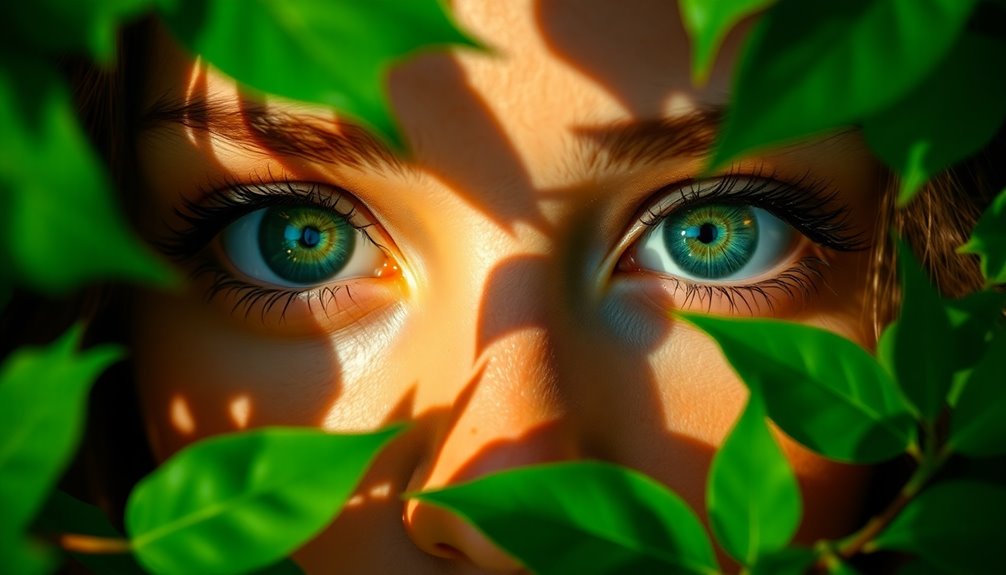
Enhancing the vibrancy of your green eyes can be influenced by various environmental factors. Sunlight exposure, for example, can make your green eyes appear brighter, but it also means you need proper UV protection due to increased sensitivity.
The changing seasons and different lighting conditions can dramatically alter how your eye color is perceived, sometimes highlighting their vividness or, at times, muting them.
Your diet plays a significant role in maintaining eye health, too. Foods rich in carotenoids, lutein, and zeaxanthin can help enhance and protect the clarity of your green eyes.
Staying hydrated is just as important; adequate hydration supports overall eye clarity and vibrancy. Quality sleep is essential as well, allowing your eyes to recover and remain radiant.
Additionally, lifestyle choices, including certain medications, can lead to subtle changes in your iris pigmentation. While significant alterations in eye color are rare in adulthood, minor shifts can still occur.
Green Eyes and Popular Culture

In popular culture, green eyes often symbolize depth and allure, enchanting audiences across various mediums. This eye color, marked by its rarity, captures the imagination in unique ways. Here are some aspects of how green eyes manifest in popular culture:
- Literature and Film: Iconic characters like Scarlett O'Hara from "Gone With the Wind" and Harry Potter, whose green eyes signify exceptional abilities, showcase the inherent beauty and symbolism of this color.
- Music: Songs, such as Coldplay's "Green Eyes," celebrate the beauty and uniqueness associated with this eye color, weaving emotional depth into their lyrics.
- Visual Arts: Artists often depict green eyes to emphasize complexity and emotional depth, making them a fascinating subject in paintings and photography.
- Celebrities: Stars like Elizabeth Taylor and David Bowie have contributed to the cultural fascination surrounding green eyes, reinforcing their status as a symbol of exceptional beauty.
Social media amplifies these themes, with influencers setting beauty trends that highlight the allure of green eyes, further solidifying their place in popular culture.
Spiritual Significance of Green Eyes
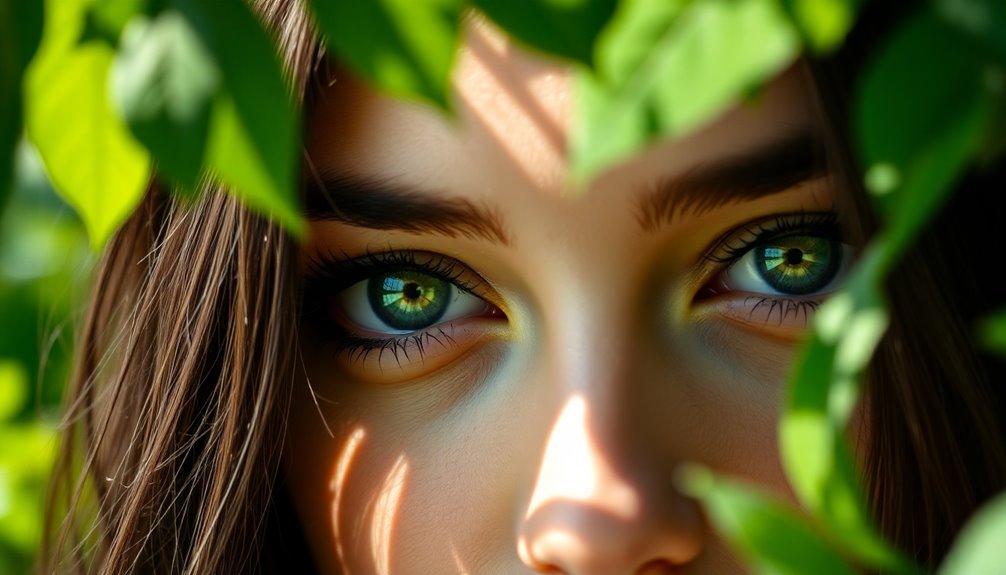
Many believe that green eyes carry a profound spiritual significance, linking those who possess them to nature's vibrant energy. If you have green eyes, you might feel a deep connection to the natural world, reflecting the lush landscapes and vibrant ecosystems around you. This bond often fosters heightened intuition, allowing you to perceive the emotions and intentions of others more easily.
The spiritual significance of green eyes extends to sensitivity towards seasonal changes and lunar cycles, enhancing your appreciation for the earth's rhythms. You may find yourself drawn to spiritual practices like meditation and energy healing, which amplify your natural intuitive gifts.
This connection to the universe can lead you to explore your empathetic nature further, as you deeply understand the emotional depth of those around you.
Many green-eyed individuals pursue careers in counseling, social work, or creative arts, reflecting their innate ability to empathize with others. Your green eyes not only symbolize beauty but also a profound spiritual journey, encouraging you to embrace your unique gifts and foster connections with the world around you.
Frequently Asked Questions
What Does the Green Eye Symbolize?
Green eyes symbolize a unique blend of rarity and depth. When you see someone with green eyes, you might think of their individuality and the mystique that surrounds them.
These eyes can evoke feelings of envy or jealousy, reflecting emotional complexities in relationships. You may also associate them with themes of growth and renewal, suggesting opportunities for personal development.
Culturally, they're linked to intuition and supernatural traits, enhancing their enchanting allure.
What Does the Metaphor Green Eyes Mean?
Glimmering green eyes gleam with a gaze that captivates. When you think of the metaphor "green eyes," it often signifies emotion and depth.
These striking eyes can symbolize envy, revealing hidden desires or jealousy in relationships. Yet, they also represent intuition and insight, suggesting a keen perception of others' feelings.
Ultimately, green eyes reflect a unique blend of beauty, sensitivity, and the complex emotions that weave through human connections.
What Do the Great Green Eyes Symbolize?
The great green eyes symbolize rarity and uniqueness, offering an aura of mystery and allure.
When you think of these striking eyes, you might associate them with themes of envy, luck, and individuality. They represent emotional depth and heightened intuition, allowing you to connect with others profoundly.
Culturally, they embody growth and renewal, suggesting personal transformation.
In literature and art, characters with green eyes often possess exceptional abilities, reinforcing their complexity and depth.
What Is the Myth About Green Eyes?
The myth about green eyes often paints them as mysterious and alluring.
In various cultures, you might find that people link green eyes to supernatural abilities or even witchcraft. You could hear tales of green-eyed beings, like leprechauns, who embody luck and mischief.
Some traditions suggest these individuals possess heightened intuition or insight, making them fascinating figures in folklore.
Conclusion
To sum up, green eyes shine like emeralds, drawing us into their mysterious depths. Their rarity and rich symbolism weave a fascinating tapestry of cultural and personal meanings. Whether you see them in art, literature, or everyday life, green eyes invite you to explore the stories and emotions behind their vibrant hue. So, next time you encounter those striking gazes, remember the layers of significance they carry, each one a glimpse into a world waiting to be discovered.

